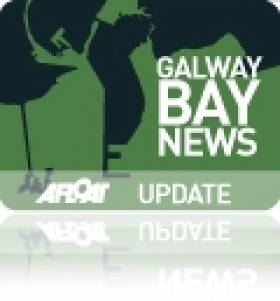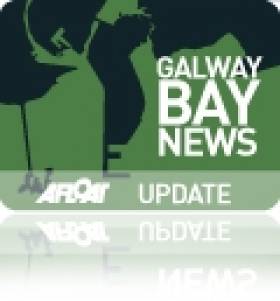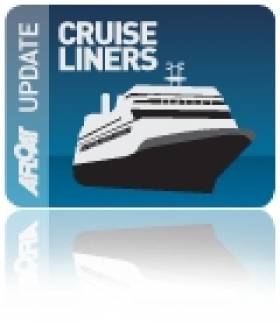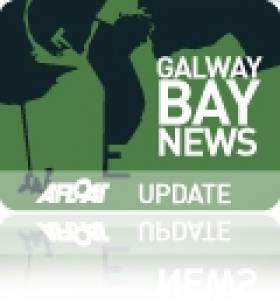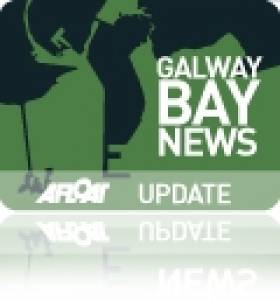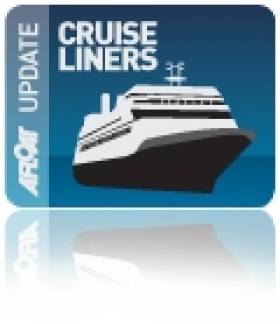Displaying items by tag: Galway Harbour News
#VESSEL VOLVO VILLAGE – As previously reported the ocean going heavy-lift container cargoship Deo Volente (2007/2,999grt) which is carrying the spectacular Volvo Ocean Race 'pop-up' spectator village from Lisbon is en-route off the Clare coast and is due to dock in Galway Docks this afternoon, writes Jehan Ashmore.
The high-tech village which is assembled from 70 crates and is one of two such villages which have accompanied the race across the globe is in the holds of the 105m long Dutch owned vessel. When Deo Volente enters through the dock she is to berth at Dún Aengus Dock North.
According to Capt. Brian Sheridan, Harbourmaster of the Galway Harbour Company, the containership is the first the port has ever had to handle and the unloading is part of "the unfolding jigsaw that is the Volvo Ocean Race".
The unloading process will create huge excitement as the village emerges from its containers and transforms the dockside into a gigantic sports and entertainment arena.
Deo Volente is operated by Hartman Seatrade, which they classify as a mini heavy-lift vessel. She is capable of carrying vessels as deck-cargo, unusual sized cargo as well as 236 TEU containers. On board are two 120 mt (metric tonnes) cranes, built by Liebherr which are mounted on the starboard side. Using both cranes the loading gear can handle a maximum tandem total weight of 240 mt.
The appearance of such a vessel will no doubt bring back memories to many Galwegians when in 2011 there was the saga of attempting to load two former Aran Islands fast-ferry sisters bound for new owners in Mauritius.
Albeit on this occasion of the impending Volvo Ocean Race, the process of unloading the pop-up village is far more conventional in the form of containers, though what is required is the 60 specialist construction workers involved in the task of assembling the village. The vessel is to stay in port overnight and scheduled to depart tomorrow afternoon.
As for last year's protracted loading of the fast-ferries, it was heavy-lift ship Thor Gitta (4,078grt) that stepped in after another similar vessel, Pantanal (7,837grt) ran aground in Rossaveal on 31 March. It was from the joint fishing and ferry port, where the ferries were originally due to be loaded.
Instead the ferries had to transfer to Galway Harbour where the vessel eventually departed nearly a month later on the 8,300 mile delivery voyage to the Indian Ocean.
Chinese Examine Galway Port Redevelopment
#GALWAY HARBOUR - The redevelopment of Galway Port was discussed during the Taoiseach's recent visit to China. It was one of a number of key infrastructure projects that could benefit from a deal that was signed by An Taoiseach to allow Chinese investment in Irish assets.
In an agreement signed in Beijing by Enda Kenny and Chinese premier Wen Jiabao, it will facilitate engagement by the National Treasury Management Agency (MTMA) with China's sovereign wealth fund in relation to possible investment in Ireland.
Redevelopment plans for the port are set to be lodged with An Bord Pleanála in August. For more on the story Galway News.ie reports.
Cruise Caller Line-Up for Galway Harbour
#CRUISE LINERS- Galway Harbour can look forward to welcoming nine cruise calls to the mid-west port this year, with the first visitor being Arion which is scheduled to arrive in Galway Bay during late May, writes Jehan Ashmore.
Arion harks back to an era of the more classically designed ships with graceful sweeping lines. The 5,888 tonnes veteran vessel was launched in 1965 at Pula, in Croatia, as Istra and later in her career she underwent a major reconstruction in a Lisbon shipyard during 2000.
Cruise & Maritime Voyages (CMV) will be sending their Marco Polo, another classic veteran, in July as part of a 12 night 'Emerald Isle' discovery cruise departing Tilbury, with en-route calls to Cobh and Glengariff the previous day.
For a full listing of the cruise-calls schedule click HERE.
Plans for New Galway Port Will Have to be Withdrawn
#GALWAY HARBOUR- A proposed €200m outer deepwater port will have to be withdrawn due to a failure by Galway Harbour Company to secure necessary approvals for preliminary investigations, according to a report in yesterday's Irish Times.
The ambitious plan, which intended to build following the success of the stopover of the Volvo Ocean Race in 2009 (and to return next July), was due to have been submitted directly to the planning appeals board some months ago under the Strategic Infrastructure Act.
However, the harbour company was advised that site investigation works for the application were conducted without first securing full approval for a foreshore licence from the Department of the Environment.
Taoiseach Enda Kenny is said to have been informed of the setback, which is expected to delay submission of a planning application to An Bord Pleanála until the mid-2012.
The development proposed transferring port operations outside from the existing single-dock facility (click HERE) south into Galway Bay, where reclaimed land in deeper waters would accommodate larger cruise-ships (click HERE) in addition a freight rail-link and a 200-berth marina.
Galwegian Special Olympian Athletes Celebrate On board Navy's Flagship
The world games which were held during June and July saw over 7,500 athletes from 185 countries participate in the Greek capital. Team Ireland in total brought home 107 medals, with athletes from Galway securing 11 medals and a number of ribbons in a variety of sports.
Speaking about the reception, Regional Director Myra Merrick said: "We are honoured to have the Naval Service docking in Galway especially for the function. The athletes deserve a warm reception and recognition for their wonderful success. It's a huge achievement in itself to participate at World Games level, let alone bring back a medal".
"The event presents an exceptional opportunity for the public to extend congratulations to our local sporting heroes, explore the Defence Forces vessel and meet the officers" she added.
The 1984 built /1,910 tonnes 'helicopter patrol vessel' and her seven fleetmates are all each assigned to a particular charity. In the case of L.E. Eithne she is associated with Our Lady's for Sick Children, Crumlin in Dublin.
Cruise-Goers Head for the Galway Races
The vessel first visited Galway in 2009 but this call will be her last year operating under the Spirit of Adventure cruise banner. The company are to replace the vessel next season with the Saga Pearl II which will be transferred from the parent company Saga Cruises and renamed Quest for Adventure.
Prior to the Spirit of Adventurer's call, the 226 passenger Le Diamant arrived from St. Malo last Friday. She became the first vessel to make a call to the 'City of the Tribes' on behalf of her French operators, Cie de Ponant. Her passengers were taken on tours of the city, Connemara and the Aillwee Caves in neighbouring Co. Clare. The vessel is due to return early next month.
With three cruise-calls this year the port is set to increase this figure to 7 in 2012 arising from the ports campaign over the last two years. Paul Carey, Chairman of the Harbour Company, said "We are beginning to see the fruits of this campaign and look forward to growing Galway's association with the return of the majestic passenger liners to Galway".
"The passenger liner The World has been confirmed for a two-day visit in August 2013 which is a great endorsement of Galway as a cruise destination".
The call by the world's first ocean-going luxury resort vessel will also be another first for Galway. Operators of the 43,524gt vessel, Residences at Sea have made previous Irish ports of call to include Dublin, for more on her to the capital last August click HERE.
- Dublin Port
- Galway Bay
- Foynes
- Shannon Estuary
- The World
- Cruiseships
- Ports and Shipping News
- city of the tribes
- Galway Harbour
- Galway Harbour News
- Mutton Island
- Le Diamant
- Cruiseliners
- Saga Cruises
- Spirit of Adventure Cruises
- Spirit of Adventure
- Galway Harbour and Bay news
- Galway Port
- Port of Galway Company
- Ponant Cruises
- Galway Races
- The Galway Races Ballybrit
- Ballybrit Race Course
- Port of Foynes
- Saga Pearl II
- Quest for Adventure
- Shannon Estuary and port news
- The World cruise liner
- Residences at Sea
- The World Residences at Sea
- Irish cruise ports of call
- Irish cruise calls
- Cruiseships to Ireland
- Cruise Companies visiting Ireland
- West of Ireland cruise callers
Fishing Exhibition Show Heads for Galway
The exhibition times are Friday 4th March (10:00am - 5:30pm) and on Saturday 5th March the opening hours are repeated (10:00am - 5:30pm). For further information on the trade-only show Tel: (053) 74 954 8037 / 954 8935 or by clicking here


























